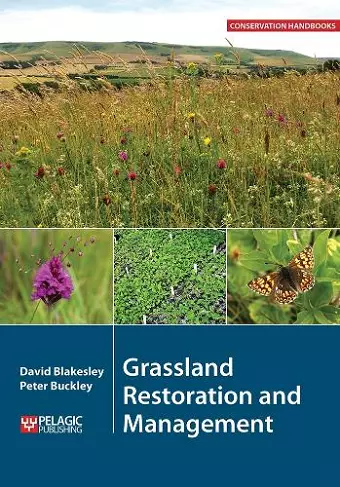Grassland Restoration and Management
David Blakesley author Peter Buckley author
Format:Hardback
Publisher:Pelagic Publishing
Published:4th Apr '16
Currently unavailable, and unfortunately no date known when it will be back
This hardback is available in another edition too:
- Paperback£34.99(9781784270780)

Following the destruction of 95% of meadows during the twentieth century, there is an urgent need to understand what little unspoiled habitat remains in order to plan the management and restoration of existing sites, as well as re-creating future grassland habitats. This book is a much-needed guide to grassland restoration and management.
Providing a thorough overview of recent research on grassland restoration and its implications for practical grassland restoration and management, it introduces grassland communities and the wildlife they support, including examples of species of conservation concern, and considers the management of semi-natural grassland habitats with particular emphasis on drier grassland habitats.
Chapters cover:
- Grassland character and communities
- Introduction to grassland wildlife
- Managing semi-natural grassland
- Grassland restoration – threats and challenges
- Opportunities in grassland restoration
- Plant material for grassland restoration
- Defining success in grassland restoration.
A variety of management techniques are examined, including soil amendment, cultivation, harvesting and maintenance in creating suitable conditions for the successful restoration of species-rich grasslands.
It is essential reading for conservationists, site owners or managers, practitioners, conservation organizations and students of ecological restoration with an interest in the creation of new grassland habitats, the restoration of semi-natural grassland, as well as the continuing management of semi-natural (unimproved) grassland communities.
Blakesley and Buckley’s book provides great support to the practical implementation of grassland restoration and grassland management. Although the book focuses strongly on the United Kingdom, there are links to restoration activities applied in other parts of Europe. The management and restoration techniques discussed can be used outside the United Kingdom very well, not only as they apply to site management and restoration but also in education.
-- Peter Torok * Policy and Practice in Restoration *This is a must-read book for everyone involved in projects involving the management and restoration of grasslands, as this is the core driver and motivation of this compilation. This book will certainly be a great help in improving assessments and planning, and in solving real-world problems and setbacks inherently associated with these types of projects.
-- Pedro Aragón * Journal for Nature Conservation *Overall, Grassland Restoration and Management is especially useful for European grassland practitioners and the assessment of grazing effects, seeding methods, and nutrient management approaches would be easily transferable for those managing grasslands elsewhere in the world.
-- Kathryn Yurkonis * Landscape Ecology *The book is pioneering in many ways, as it provides a comprehensive overview of the conservation status, threats and nature conservation and restoration perspectives of dry grasslands in the United Kingdom. There is an urgent need for such books on grassland restoration and management in many regions. This publication is a nice example to follow, and hopefully similar syntheses will be published in other countries as well…
To sum up, this is a comprehensive and practice‐oriented book, which can be recommended for conservationists, site managers and also for scientists who are concerned with the conservation and restoration of grassland habitats.
-- Orsolya Valkó * Bulletin of the Eurasian Dry Grassland Group *This new book is well formatted and there are ample photos and tables to complement the text. The authors successfully pull together the latest research and a wealth of practical advice on the ways to preserve, restore and create natural grasslands. Various management and restoration techniques such as soil amendment, reseeding and harvesting are all comprehensively covered. As are the threats and challenges of conserving this declining habitat, along with remedial measures available to land managers. Other chapters provide detailed information about the different grassland communities and their associated wildlife. My one minor criticism is that there could have been more emphasis on wet grassland communities, which are hardly mentioned. Despite this I am certain this latest edition in the Conservation Handbook series will be essential reading for land managers and site owners alike.
-- Chris Gregory * About Birds, British Trust for Ornithology *This book is designed for those involved in the conservation and management of grasslands in the UK. While grasslands represent some 37% of the surface area of the UK, only about 2% of that area can be considered unimproved or semi-natural. Sadly, around 86% of the unimproved grasslands are hay meadows. It is not therefore surprising that such grasslands are of major conservation concern, and some categories have been recognised as priority areas in UK Biodiversity Action Plans and EU Habitat Directives…
I was pleased to see the importance of grasslands for other organisms emphasised, with valuable synopses of associated invertebrates of concern, including butterflies, birds, mammals, reptiles, and fungi (even saprobes and pathogens). Particular attention is given to grazing regimes, including management of cattle and sheep, and mechanical harvesting. The treatments are pragmatic and hands-on, also with discussions of when to use herbicides and coping with invasives, not least bracken…
The whole is lavishly illustrated with coloured photographs, both of organisms, grassland types, and management operations. The authors are both experienced ecological consultants, and this is reflected in a welcome hands-on approach throughout. This is surely destined to be the major reference work on grasslands for conservation practitioners in the UK, and merits a wide distribution amongst county Naturalists’ Trusts, local authority ecologists, and those responsible for the management of grassland SSSI’s.
-- David L. Hawksworth * Biodiversity and ConservatiISBN: 9781907807800
Dimensions: unknown
Weight: 823g
272 pages